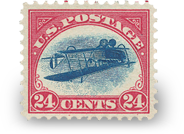| Introduction | Why Grade Stamps? | What is Grading? | PSE Grading System | Soundness | Centering | Combining Soundness and Centering | Eye Appeal | Gum Condition | Appendix |
Because grading is an attempt to assign a fair market value to a stamp, and because stamps have value, grading is important. Tiny chunks of coal for example, have no value and consequently need not be graded. Subject that coal to sufficient heat and pressure and you end up with a diamond. And since diamonds have value, you have the GIA. In essence, grading derives its importance and meaning because the items being graded have value in the market.
The correlation between a stamp's grade and its market value is absolute, and the absence of explicit standards for determining a stamp's grade leave the market with an undesirable degree of uncertainty, particularly for novice collectors and sight-unseen buyers. While centering has been widely discussed for years, it is only one component of a stamp's total grade. A perfectly centered stamp that has been reperforated is not a Gem.
Other collectibles markets, such as rare coins, sportscards, comic books and currency have made tremendous strides over the past two decades in establishing and adopting uniform grading standards. The primary beneficiary of this trend has been the consumer, who is now able to buy and sell on a far more level playing field than before. Dealers and suppliers have benefited as well, as greater consumer confidence and satisfaction has resulted in higher sales volume and more widespread market participation.
Professional Stamp Experts (PSE) believes that the time for adopting and implementing a uniform, consistent and widely accepted grading scale for postage stamps is now. The result of such efforts to date has been of benefit to both buyers and sellers of collectible stamps. Buyers are purchasing stamps with increased confidence. Price guides such as the Stamp Market Quarterly and Scott Valuing Supplement have begun to adequately address the full range of grades in which stamps are found, and are providing market values for stamps ranging from faulty, defective copies through superb, gem examples. In general, the philatelic market is becoming a safer, more inviting place. If the hobby of philately is to continue to grow and prosper, it is essential that new buyers feel comfortable entering the market.


